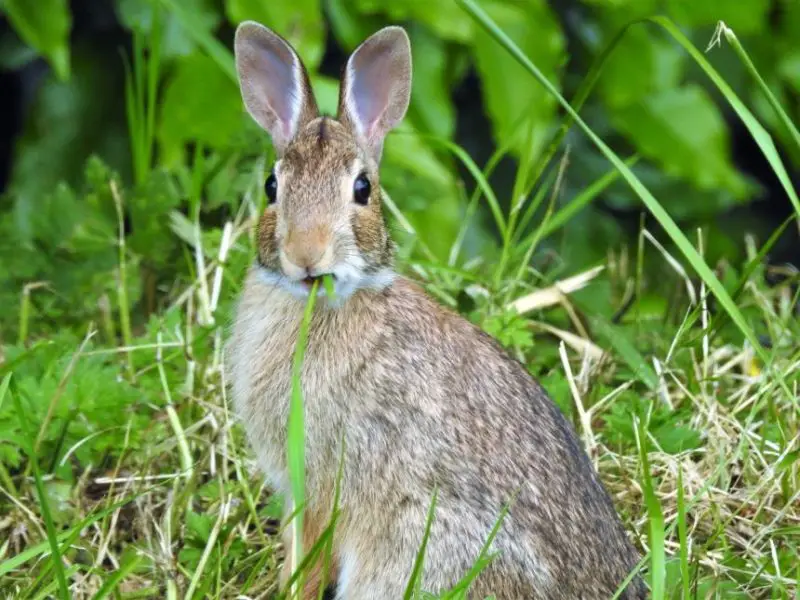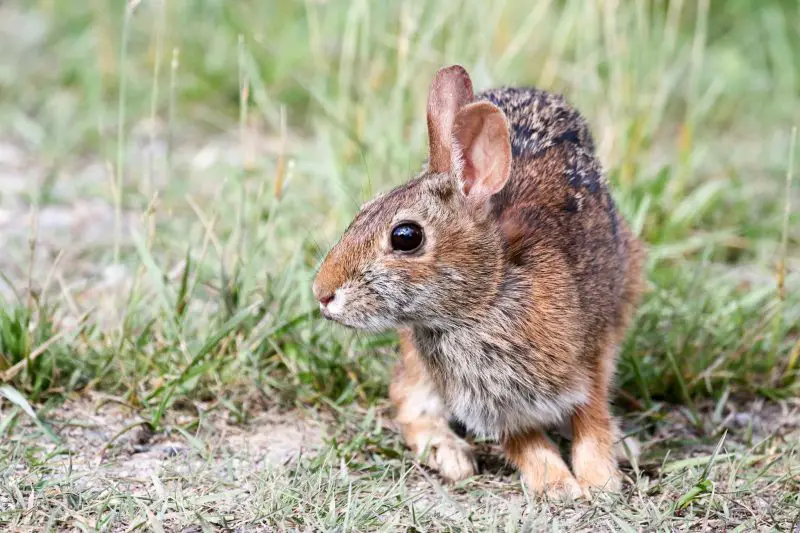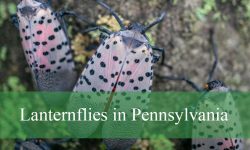New Jersey’s diverse landscapes, from forests to farmlands and suburban areas, provide ideal habitats for several wild rabbit species. These small mammals are an integral part of the ecosystem, serving as prey for many predators and contributing to vegetation control.
Wild rabbits in New Jersey are often seen darting across fields or hiding among shrubs and brush. Their keen senses and quick reflexes make spotting them a delightful challenge for wildlife enthusiasts and photographers alike.
In this guide, we’ll explore three types of wild rabbits found in New Jersey, highlighting their distinctive features, behavior, and habitats to help you identify them in the wild.
Common Wild Rabbits Found in New Jersey
Eastern Cottontail (Sylvilagus floridanus)

The Eastern Cottontail is the most common wild rabbit in New Jersey and throughout much of the eastern United States. This species is easily recognized by its reddish-brown to grayish fur, large dark eyes, and the distinctive white underside of its tail, which looks like a puff of cotton when it runs. Adults typically measure between 15 to 18 inches in length and weigh around 2 to 4 pounds, making them medium-sized compared to other rabbits. Their rounded body shape and long ears allow them to blend into grassy fields and forest edges.
When it comes to behavior, Eastern Cottontails are primarily crepuscular, meaning they are most active during dawn and dusk. They spend much of the day resting in shallow depressions called “forms,” often hidden beneath shrubs or tall grass. These rabbits rely heavily on their speed and agility to escape predators, capable of running in quick, zigzagging patterns to confuse hawks, foxes, coyotes, and domestic pets. Their keen sense of hearing and wide field of vision also play vital roles in their survival.
Eastern Cottontails feed on a wide variety of plants, including grasses, clover, dandelions, and garden vegetables during the warmer months. In winter, when greenery is scarce, they gnaw on woody plants, twigs, and bark. This adaptability allows them to thrive in suburban areas as well as farmlands and natural meadows. Because of their feeding habits, they are often considered both beneficial for seed dispersal and a nuisance to gardeners.
In New Jersey, Eastern Cottontails can be found statewide in fields, forest edges, suburban neighborhoods, and parks. They are highly prolific breeders, with females capable of producing multiple litters each year, each containing three to eight young. A fun fact about this species is that newborn cottontails are born hairless and with closed eyes, yet within a month, they are independent and ready to survive on their own. This remarkable reproductive ability has helped the species remain abundant despite predation pressures.
New England Cottontail (Sylvilagus transitionalis)

The New England Cottontail is a much rarer species compared to the Eastern Cottontail and is considered a species of conservation concern. At first glance, it looks similar to the Eastern Cottontail, but it has subtler differences such as a slightly smaller body size, averaging 14 to 17 inches long, and a black spot between the ears that helps with identification. Its fur is a mix of brown and gray, and unlike its more common cousin, it tends to appear darker and less reddish overall.
Behaviorally, the New England Cottontail is more secretive than the Eastern Cottontail. It prefers dense thickets, shrubby areas, and young forests where it can find thick cover from predators. This reliance on dense habitats makes it harder to spot, and populations have declined due to habitat loss from urban development and forest maturation. Like other rabbits, it is preyed upon by hawks, owls, foxes, and coyotes, but its survival strategy depends heavily on staying hidden rather than relying solely on speed.
The diet of the New England Cottontail is similar to other cottontail species, consisting of grasses, forbs, and shrubs. In winter, it switches to woody vegetation, feeding on twigs and bark to sustain itself. This species plays a role in shaping its environment by influencing the growth of low shrubs and young saplings through its browsing habits. However, its dependence on a specific type of habitat makes it more vulnerable to environmental changes.
In New Jersey, the New England Cottontail has a very limited distribution and is found mainly in the northern part of the state, particularly in areas with dense shrubby cover. Conservation programs have been introduced to restore suitable habitats to support this species. A fun fact is that the New England Cottontail was once much more widespread, but today it is often outcompeted by the Eastern Cottontail, which is more adaptable to suburban and open habitats.
Appalachian Cottontail (Sylvilagus obscurus)

The Appalachian Cottontail is another rare rabbit species in New Jersey, with a distribution mostly restricted to higher elevations and mountainous regions. It closely resembles both the Eastern and New England Cottontails, but one of its distinguishing features is a darker coat with a slightly more yellowish or buffy tint on the nape of its neck. Adults usually range from 14 to 17 inches long and weigh around 2 to 3 pounds. Their smaller range and preference for upland forests make them one of the least observed rabbits in the state.
In terms of behavior, the Appalachian Cottontail is elusive and tends to inhabit rugged, forested habitats with dense undergrowth. It is also more solitary compared to the Eastern Cottontail, with individuals establishing small home ranges in areas with sufficient cover. Like other rabbits, it is crepuscular and nocturnal, foraging mostly at dawn and dusk while avoiding daytime predators. Its main threats include raptors, foxes, bobcats, and coyotes.
The diet of the Appalachian Cottontail is highly dependent on its mountain environment. During spring and summer, it feeds on grasses, clover, and herbaceous plants. In winter, it consumes woody stems, buds, and bark to survive the scarcity of green vegetation. This seasonal feeding behavior helps it adapt to harsher climates but also ties it closely to the health of forest ecosystems in the Appalachian region.
In New Jersey, this rabbit is primarily found in the northwestern part of the state, particularly in the Appalachian Mountains and forested ridges. Because of its specialized habitat requirements, it is less common than the Eastern Cottontail and more vulnerable to changes in forest structure. A fun fact about the Appalachian Cottontail is that it is sometimes referred to as a “mountain cottontail,” but it should not be confused with the Western Mountain Cottontail found in the Rockies—it is an entirely separate species unique to the Appalachians.
Comparison of Wild Rabbit Species in New Jersey
Rabbit Species |
Size (inch / pound) |
Fur Color |
Behavior |
Habitat / Distribution |
Conservation Status |
|---|---|---|---|---|---|
Eastern Cottontail |
15–18 in / 2–4 lbs |
Reddish-brown to gray, white tail underside |
Crepuscular, active at dawn and dusk, escapes predators by zigzag running |
Throughout New Jersey: fields, forest edges, suburban areas |
Common, not threatened |
New England Cottontail |
14–17 in / 2–4 lbs |
Gray-brown, darker than Eastern Cottontail, small black spot between ears |
Secretive, stays hidden in dense thickets, avoids predators by hiding |
Northern New Jersey, dense shrublands and young forests |
Rare, conservation concern |
Appalachian Cottontail |
14–17 in / 2–3 lbs |
Dark brown with buff/yellowish nape |
Elusive, solitary, mostly nocturnal and crepuscular |
Northwestern New Jersey, Appalachian forested ridges |
Rare, vulnerable |
Best Time and Places to Observe Wild Rabbits in New Jersey
The best time to observe wild rabbits in New Jersey is during dawn and dusk, as most species are crepuscular, meaning they are most active during these low-light periods. Early mornings and late afternoons offer the highest chance to see them foraging, moving between cover, or interacting socially.
For Eastern Cottontails, they can be spotted almost anywhere in the state, including open fields, forest edges, suburban yards, and parks. Look for shallow depressions or “forms” where they rest during the day.
The New England Cottontail prefers dense shrublands, thickets, and young forests, mostly in the northern regions of New Jersey. Observers need patience and quiet, as these rabbits rely heavily on cover and are more secretive.
The Appalachian Cottontail is best observed in northwestern New Jersey, especially in mountainous forested areas and Appalachian ridges. Their solitary and elusive nature makes sightings rare, so spotting them often requires careful hiking along trails with dense undergrowth.
Fun tip: Using binoculars and keeping a safe distance helps avoid startling these cautious creatures while giving a clear view of their natural behavior.
FAQs About Wild Rabbits in New Jersey
What types of wild rabbits are found in New Jersey?
New Jersey is home to three main wild rabbit species: the Eastern Cottontail (Sylvilagus floridanus), the New England Cottontail (Sylvilagus transitionalis), and the Appalachian Cottontail (Sylvilagus obscurus). The Eastern Cottontail is the most common, while the other two are rarer and more habitat-specific.
How can I identify each rabbit species?
The Eastern Cottontail has reddish-brown to gray fur and a distinctive white tail. The New England Cottontail is darker gray-brown with a small black spot between its ears. The Appalachian Cottontail has a darker coat with a yellowish or buff-colored nape, making it slightly different from the other two. Size differences are subtle, but behavior and habitat can help with identification.
When is the best time to see wild rabbits?
Wild rabbits in New Jersey are crepuscular, meaning they are most active at dawn and dusk. Observing them during these times increases the likelihood of spotting feeding, moving, or interacting naturally.
Where can I find wild rabbits in New Jersey?
Eastern Cottontails are found statewide in fields, forest edges, suburban areas, and parks. New England Cottontails prefer dense shrublands and northern forests. Appalachian Cottontails are restricted to the northwestern mountainous areas and forested ridges.
What do wild rabbits eat in New Jersey?
Wild rabbits are herbivores. They feed on grasses, clover, herbs, and garden vegetables during warmer months. In winter, they eat twigs, buds, and bark when green vegetation is scarce. Their diet varies slightly by species depending on available habitat.
Are wild rabbits threatened in New Jersey?
The Eastern Cottontail is common and not threatened. The New England Cottontail and Appalachian Cottontail are rarer and vulnerable due to habitat loss and competition, making conservation efforts important to protect their populations.
What predators hunt wild rabbits in New Jersey?
Common predators include hawks, owls, foxes, coyotes, bobcats, and domestic pets like dogs and cats. Rabbits rely on speed, agility, and camouflage to escape predators.
Can I attract wild rabbits to my backyard?
Yes, by providing dense shrubs, grassy areas, and safe cover, you can attract Eastern Cottontails. Avoid using pesticides, and offer natural foods like clover and leafy greens, but remember that rabbits are wild animals and should not be handled.






